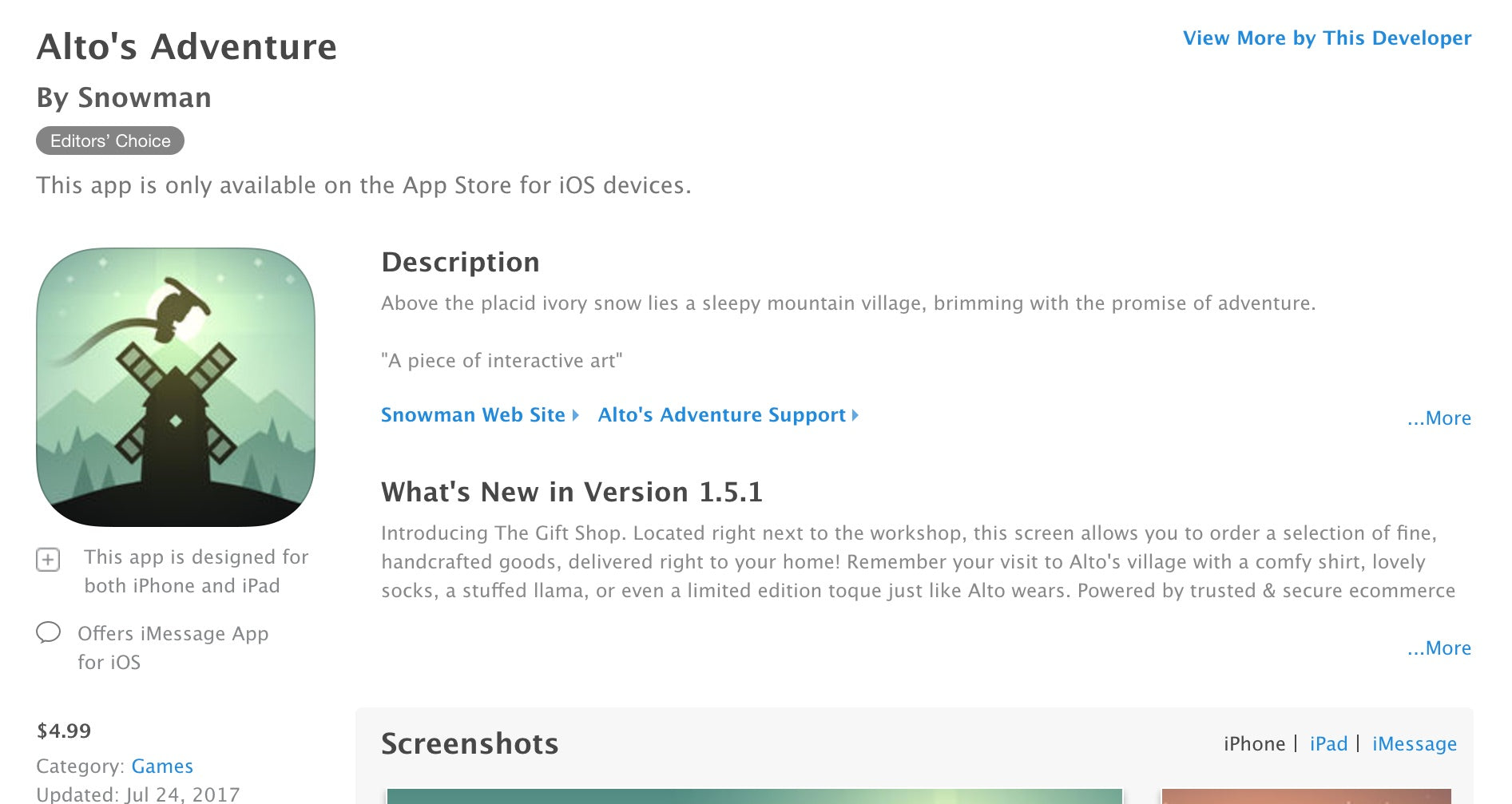Games are more than just a pastime or even pieces of interactive art. They’re entire worlds that are built for us to visit, that are able to pull us back from time to time, that still cross our minds even as we go about our lives.
It’s these worlds that Snowman—a development studio based in Toronto— believes in building, and it's become the basis for many of the decisions they’ve made as both a business and as the developer of the award-winning indie game, Alto’s Adventure.
That philosophy is also the reason they’re among the first in their industry to incorporate a merch store directly into their game with Shopify’s Unity Buy SDK—a decision that resulted in them making 60% of their annual revenue from product sales in 30 days.
But first, you’ll need to understand a little bit about how Snowman and Alto’s Adventure came about.
Alto’s Adventure: The Making of an Award-Winning Game

Snowman might be a small development studio based in Toronto, Canada, but it consists of a distributed team of over 35 people around the world.
It all started when co-founders, and childhood best friends, Ryan Cash and Jordan Rosenberg set out to build apps to take advantage of all the attention that was on the then-new Apple App Store.
After a few attempts at building productivity apps—including Checkmark and Shifts—Snowman found its way into gaming with their first minimalist game, Circles. None of their early projects, however, were what they would call a success.
It wasn’t until Ryan fell sick and spent days on end playing Ski Safari that he was reminded of his fond memories of both snowboarding down the slopes in real life and playing Tony Hawk’s Pro Skater as a kid. It didn't just inspire his vision for a new game, but a feeling that it had to capture.
And so they partnered with Harry Nesbitt, a talented illustrator and developer based in England, and gave him full creative control over designing the game and the world that is now Alto’s Adventure.
After 18 months, Alto’s Adventure was finally released in the iOS App Store on February 19th, 2015 and became an almost-instant success.
The game itself is an endless runner, taking reference from classics like Journey or Tony Hawk’s Pro Skater, where players are tasked with collecting coins and doing insane tricks.
Where Alto really differentiates itself is in its design, fluidity, and sound, all of which come together to create a meditative experience unlike any other. The beautiful landscapes allow the player to escape into Alto’s world, where "everything else sort of just disappears" when "in rhythm with the mountain."
The game received high-praise from reviewers over it’s unique art style and aesthetics. It went on to win multiple awards including the App Store Best of 2015, Product Hunt’s Game of The Year, and a Pocket Gamer Gold Award. There’s even a successor that’s soon to come in the form of Alto’s Odyssey.
But underneath it all, there’s the beating heart of a business. And on that front, Snowman has made some careful and well-researched decisions.
Alto’s Business: Monetizing a Mobile Game

Monetizing a digital product like a game can be a tricky endeavor, especially when you consider the backlash from consumers for add-on downloadable content that you need to pay for and freemium games like Farmville that let you spend real money to speed up the slow-paced grind of gameplay.
But those who do it right are seeing the results—giants like Supercell (maker of Clash of Clans), for example, have pulled in over $2.3B in revenue with digital purchases in their games.
Snowman, however, opted to take a different approach. They decided to segment their monetization strategy based on device, and for good reason.
On iOS, Alto’s Adventure costs $4.99 USD to purchase and that's the only purchase you're compelled to make. For Android, though, it’s free to download and you can purchase power-ups with real world money and occasionally have the option to revive Alto when you crash by watching an ad. This is due to the smaller potential player base on Android where sales of the game alone wouldn’t be enough to sustain it.
According to Eli Cymet, the studio's Lead Producer, “On Android, Alto’s Adventure has just gotten over 20 million downloads recently, which has really allowed us to speak to a larger number of players through the game. And so the monetization is different where some of the digital goods can be purchased [with real money]. For example, for $4 you can purchase an item called the Coin Doubling Scarf.”
None of these purchases or actions are necessary to enjoy or succeed with the game—Eli emphasizes that the goal was always to monetize in an ethical way that didn’t detract from having a quality experience sliding down the slopes in Alto’s world.
This commitment to the player’s experience and creating a world that’s easy to get lost in hasn’t just shaped their digital monetization, but also their strategy with merch.
Merch as a Bridge Between the Game World and the Real World
Casual and hardcore gamers alike know the power of a strong IP—whether it’s Super Mario or Pokemon—when it comes to merch.
This still holds true with mobile gaming, as evidenced by Rovio, maker of Angry Birds, which generated more than 40% of its $200 million revenue through licensing official Angry Birds merchandise.
So given the love Snowman had received for Alto’s Adventure, the studio decided to use merch to bring Alto’s world to life.
In September 2016, Snowman launched The Snowman Store, featuring an Alto Collection of game-related products. But they didn’t simply slap game references onto a t-shirt and put a price tag on it.
With the game itself, Snowman wanted to create a wintery world that their players could escape to. Snowman saw their merchandise as an opportunity to bring that world to life. They designed their products to feel as if they could come directly from Alto's sleepy alpine village.
Merch isn’t the main game that Snowman wanted to play with Alto’s Adventure, according to Eli. Instead, it’s an extension of the world-building that they’ve already invested so much time and talent into.
Snowman wanted to ensure high quality craftsmanship for their merchandise. Alto’s Lost Llamas, for example, were handcrafted in Germany by Zimt Beadwork, using a process called Needle Felting. This enabled Snowman to form soft wool around handmade wire frames with thousands of tiny pokes.

Alto’s Toque, similarly, is handmade in partnership with Threads of Peru to ensure a high quality wool product where no two are exactly the same.
So much care was put into ensuring a connection between the digital game and their physical merch that Harry Nesbit, the creative mind that designed Alto’s world, also helped design the products themselves.
For Snowman and Alto’s Adventure players, the merchandise bridges the gap between the online world and the offline world. It provides players a way to connect with their favorite game while they're sitting at their desk, or out on a cold wintery day.
But there was still a gap between the store and the game. Until, that is, the opportunity arrived to actually build an in-game merch store where players could buy items from Alto's world without having to leave it.
Launching One of the First In-Game Gift Shops
This experience with Shopify and the Unity Buy SDK has shown us that there's demand out there [for merch] that far outweighs what you could ever expect.
In April 2017, Shopify showcased a beta version of the Alto’s Adventure in-game Custom Storefront, using the Unity Buy SDK at the Shopify Unite Conference.
On July 20th of the same year, Snowman officially launched an update to Alto’s Adventure, including a fully implemented Custom Storefront that made merch discoverable and purchasable inside the game.
The reception from fans was overwhelming.

This new Gift Shop allowed Snowman to not only unlock an additional sales channel for their merch, but also create a more immersive game experience by connecting their players with hand-crafted Alto’s goods that felt like they were lifted from the game world.
Over the first 30 days after launching the in-game store, Snowman made over 60% of their previous year's revenue from merchandise and saw 75% of net new sales come through the in-game storefront.
These are surprising results when you consider that Alto’s Adventure is a 2-year-old game, selling for around $5.
It’s crucial to us that anything in the game feels like an authentic part of that universe. Shopify’s Unity Buy SDK helped us bring the Alto Gift Shop to life exactly as we imagined it.
Gaming: A New Frontier for Commerce
If the history of commerce has taught us anything, it’s that the closer the point of purchase is to the point of engagement, the more likely people are to buy. And games engage our attention like nothing else, some for even hundreds of hours on end.
That’s why merchandise is no longer an afterthought in the gaming industry. In addition to Alto’s Adventure, other studios in the industry are following suit, including Campo Santo’s Firewatch, which lets you order prints of photos you take in-game, and Bungie’s recent $777,000 Destiny t-shirt that can be purchased for $24.99 when you’ve satisfied certain conditions in the actual game.
As Alto’s Adventure shows, players accustomed to spending anywhere between $1 to $5 on in-game digital purchases are open to paying more than $50 dollars on a a quality product inspired by the game world, like a hand-knitted llama.
Physical products let players bring a small piece of their favorite gaming worlds back with them into the real world, acting as a bridge, a badge of honor, and a reminder of fond hours of playtime.
Special thanks to Corey Pollock, who worked on the Shopify Unity Buy SDK, for contributing his research and insight.
Are you a game developer interested in selling in-game merch?
